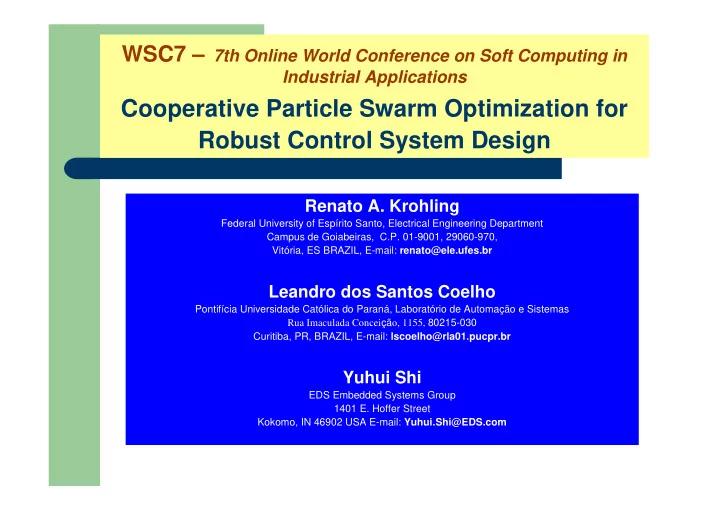

WSC7 – 7th Online World Conference on Soft Computing in Industrial Applications Cooperative Particle Swarm Optimization for Robust Control System Design Renato A. Krohling Federal University of Espírito Santo, Electrical Engineering Department Campus de Goiabeiras, C.P. 01-9001, 29060-970, Vitória, ES BRAZIL, E-mail: renato@ele.ufes.br Leandro dos Santos Coelho Pontifícia Universidade Católica do Paraná, Laboratório de Automação e Sistemas Rua Imaculada Concei çã o, 1155, 80215-030 Curitiba, PR, BRAZIL, E-mail: lscoelho@rla01.pucpr.br Yuhui Shi EDS Embedded Systems Group 1401 E. Hoffer Street Kokomo, IN 46902 USA E-mail: Yuhui.Shi@EDS.com
Abstract novel design method for robust controllers based on ! Cooperative Particle Swarm Optimization (PSO) is proposed ! design is formulated as a constrained optimization problem, i.e., the minimization of a nominal H2 performance index subject to a H-infinite robust stability constraint ! the method focuses on two (PSOs): one for minimizing the performance index, and the other for maximizing the robust stability constraint ! simulation results are given to illustrate the effectiveness and validity of the approach
Literature review of H 2 /H infinite control problem ! theoretical viewpoint of design methods (Bernstein and Haddad, 1994), (Doyle et al., 1994), (Snaizer, 1995) ! practical design method (Chen et al., 1995), (Lo Bianco, and Piazzi, 1997), (Krohling, 1998), (Krohling et al., 1999)
Problem description ! The mixed H2/Hinfinite optimal control problem can be stated as follows ! The problem of the synthesis of the controller is now one of how to solve the constrained minimization problem above. We investigate a very promising technique of evolutionary computation, i.e., particle swarm optimization to solve the optimization problem given by the expression above.
Particle swarm optimization (PSO) ! evolutionary computation technique ! originally developed by Kennedy and Eberhart in 1995 ! motivated from the simulation of social behavior instead of the evolution of nature as in the other evolutionary algorithms
Particle swarm optimization (PSO) ! each potential solution (individual) in PSO is also assigned a randomized velocity, and the potential solutions, called particles , are then “flown” through the problem space ! each particle keeps track of its coordinates in the problem space, which are associated with the best solution (fitness) it has achieved so far. (The fitness value is also stored.) This value is called pbest . ! another “ best ” value that is tracked by the global version of the particle swarm optimizer is the overall best value, and its location, obtained so far by any particle in the population. This location is called gbest .
Particle swarm optimization (PSO) t he particle swarm optimization concept consists of, at ! each time step, changing the velocity (accelerating) each particle toward its pbest and gbest locations (global version of PSO) ! acceleration is weighted by a random term, with separate random numbers being generated for acceleration toward pbest and gbest locations
Procedure of PSO – List 1 ! 1) Initialize a population (array) of particles with random positions and velocities in the n dimensional problem space. ! 2) For each particle, evaluate its fitness value. ! 3) Compare each particle’s fitness evaluation with the particle’s pbest . If current value is better than pbest , then set pbest value equal to the current value, and the pbest location equal to the current location in n- dimensional space.
Procedure of PSO ! 4) Compare fitness evaluation with the population’s overall previous best. If current value is better than gbest , then reset gbest to the current particle’s array index and value. ! 5) Change the velocity and position of the particle according to equations:
Procedure of PSO ! 6) Loop to step 2) until a criterion is met, usually a sufficiently good fitness or a maximum number of iterations (generations).
Design parameters design acceleration constants ! c1 = c2 = 2 ! Vmax set at about 10-20% of the dynamic range of the variable on each dimension ! population size selected was problem-dependent population sizes of 20-50 were probably most common.
Proposed method Optimization with two cooperative PSOs
PSO – List 2
PSO
PSO
Design example
Design example
Design example
Conclusion
Recommend
More recommend